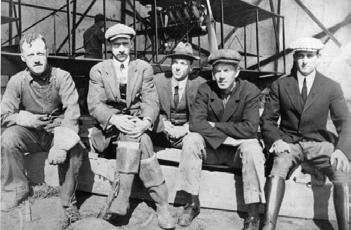
6 minute read
F E R R Y ales
Morning commuters get free ride across bay
The workday begins as commuters board the early morning ferry for a trip across San Diego Bay.
Advertisement

Passengers from all walks of life board the ferry bringing their own modes of transportation.
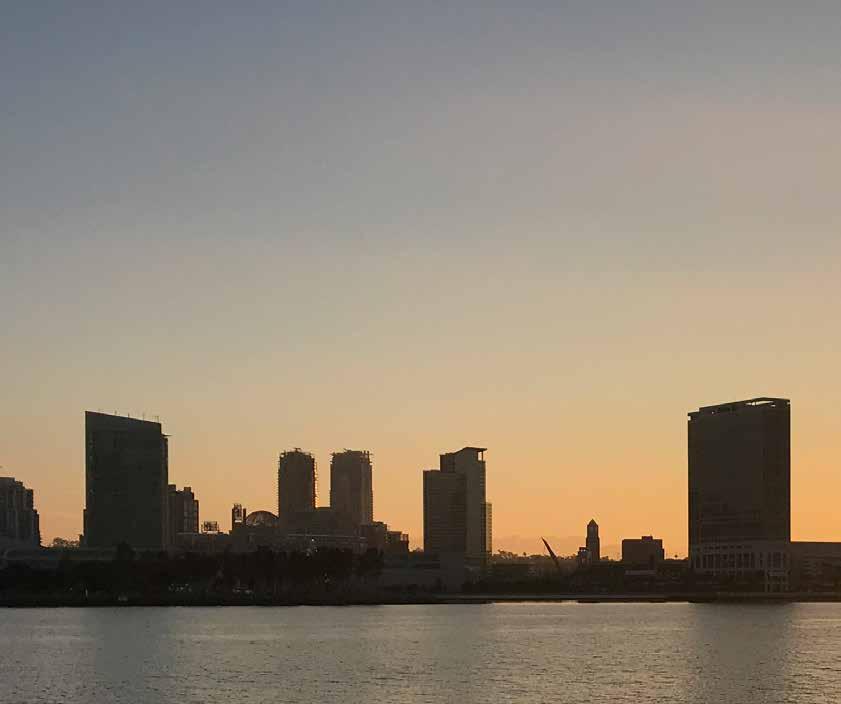

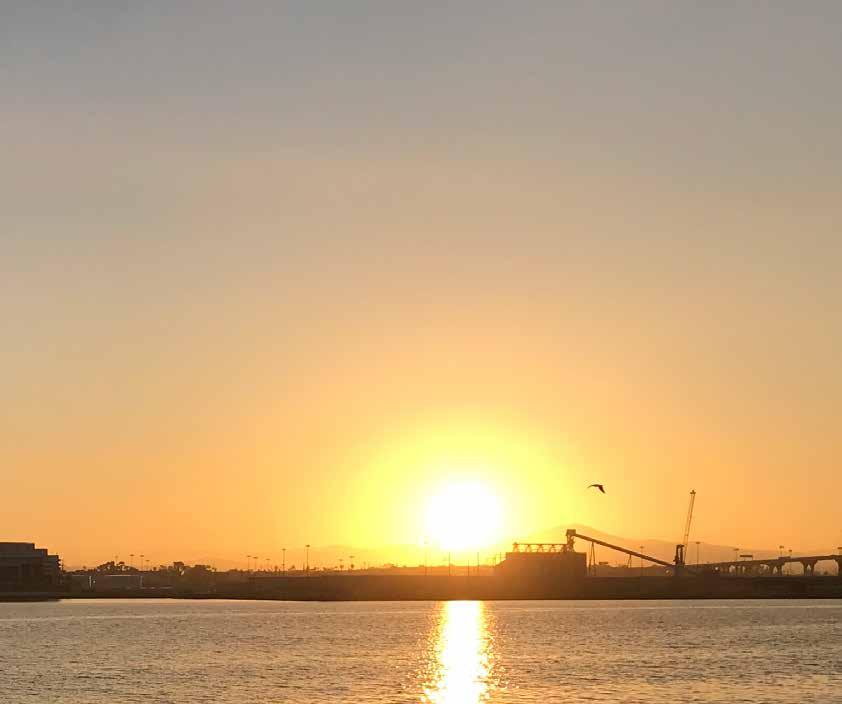
very weekday, tens of thousands of cars cross the Coronado Bridge as people head to work and home. It’s a hectic way to commute, but not everybody starts and finishes their day this way. There is a different kind of commute happening weekday mornings on the Coronado Commuter Ferry. People arrive on foot, bikes and skateboards.
In the spirit of Bike to Work Month, I spent time exploring this approach to commuting, meeting the people who embrace this unique mode of public transit.
The famous car ferries of Coronado stopped running Aug. 3, 1969 when the bridge opened. There was no ferry service until 1987 when the San Diego Unified Port Commission voted to resume operations without cars. The new ferry service also had to be approved by the state Department of Transportation and the state Public Utilities Commission.
The commuter ferry service operates between Broadway Pier in San Diego and the Coronado Ferry Landing. The service is available Mondays through Fridays, except holidays. And it’s free to anyone who crosses the bay during the hours of 5:15 to 8:50 a.m. Morning commuters are provided a free return ticket. (Funding for the commuter ferry has been provided since 1993 by a state grant administered by the City of Coronado.)
I spent time riding the morning ferries back and forth across the bay. One morning, I arrived on the pier at sunrise to the sound of bagpipes on the loudspeaker, a nice touch, compliments of the captain of the vessel. It was opening day for the Padres, so the captain also played Laurel and Hardy’s “Who’s on First” dockside while the ship emptied and reloaded.

Predawn at the Coronado Ferry Landing.

The Silvergate, the oldest working wood ferry in the United States, transits the bay between Coronado and the San Diego Convention Center. Regulars park their bicycles in a rack on the lower deck of the ferry.


The earliest ferry I took was at 6:15 a.m. from Coronado. I arrived at the Ferry Landing about 5:55 a.m., parked and walked to the pier. I sat under the shelter by myself and listened to the light rain on the tin roof. An occasional flock of sea birds swam by making quiet clucking noises. There was no activity on the bay. It was beautifully peaceful.
A few minutes after 6, I could see the ferry coming from San Diego. A couple of bicyclists arrived on the pier to start their commute. One was headed to Torrey Pines, the other to University Town Center. They don’t bicycle to work every day but one said, “I’m trying to cut down on my carbon footprint.” More people arrived, and we boarded.
I got my return ticket from Jordan, the first mate. With a return ticket you can ride on any ferry during the day.
A bike rack dominates the inside cabin space, and plastic chairs line
The captain posts useful information.
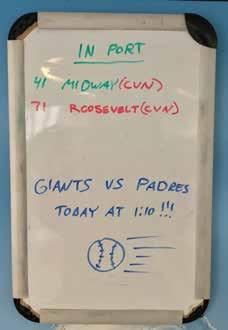
the sides with a few tables toward the stern. A white board near the entrance lists which ships are in port and two big screens alternate Flagship charter advertisements and a video of Coronado ferry history.
The ferries are part of the Flagship Cruises and Events group. The ship Cabrillo is the biggest of the four ferries and makes the commuter trip between Broadway Pier and Coronado. It has a 1,000-gallon diesel tank that uses 450 gallons per week so the fuel only needs to get topped off once a week. The Silvergate makes daily runs between the San Diego Convention Center and the Coronado Ferry Landing. According to the Flagship website, it is the oldest working wood ferry in the United States, built 1940 and originally used to transport officers and sailors to their ships anchored in San Diego Bay. Two water taxis, the Glorietta and Balboa, are backup ferries when needed.
It was a very chatty group on board the Cabrillo, surprising for so early in the morning. When we docked on the San Diego side, everyone finished their conversations, disembarked efficiently and went their separate ways. Within a few
Retired Coronado doctor John Kerley commutes to his volunteer job at the Maritime Museum (left). USS Midway Museum volunteers from Coronado often ride the ferry together.


minutes new riders were boarding the ferry for the 6:30 a.m. return trip to Coronado.
Navy personnel were the predominant riders coming from San Diego, headed to work on the bases. Most riders seemed to know each other, but once everyone was boarded, people tended to keep to themselves, checking their phones, listening to music or getting caught up on emails while the topside riders enjoyed the scenery. (A roll of paper towels is at the ready for wiping down damp seats).
I introduced myself around, and everyone was friendly except for the occasional sleep-deprived young Navy person. Most people didn’t share their names. Two guys who live about five miles north of the Broadway Pier ride their bikes to North Island every day. When asked how they deal with rainy days, they remarked in unison, “We suck it up.”
Riders from the Coronado side are a more diverse group: people scheduled for jury duty, work commuters and lots of bicyclists. A few couples start the day riding the ferry
The two Jims ride the ferry to start their bike ride on the San Diego side.
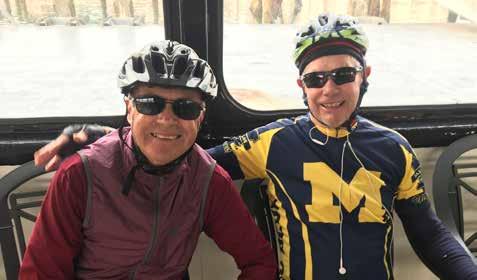
together with one heading to work in San Diego and the other making the return trip home. Maritime and Midway Museum volunteers gather in the forward cabin topside, a socializing hub.
One woman drops her kids at school before getting on the ferry to work downtown. She loves riding the ferry “because it reminds me of Portland but with better weather,” she said. A man who bicycles from Imperial Beach and works at the Navy Supply Center, Broadway complex said that when he drives his car, it can take him 90 minutes to get home in the afternoon. He decided that the ferry “is a much better way to quit work at the end of the day.”
Lots of bicyclists get on board to ride the South Bay loop or climb the hills in Point Loma. Zeke, who is in his 80s, has ridden the ferry on Tuesdays and Thursdays for more than 10 years as part of his 24-mile ride twice a week.
Stewart and Derrick, college

